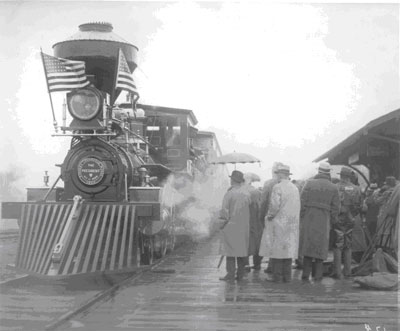|
Chances are that, when you hear the phrase “steam locomotive,” you picture an engine like the 4-4-0 “Sam Hill.” No technology symbolized 19th century America’s industrial and geographical growth better than the railroad, and no locomotive was more common than the 4-4-0.
In the 70 years from 1830 to 1900, rail lines grew from separate local routes connecting port cities with the interior to a dense and interconnected network that linked cities and towns across the continent. Likewise, locomotives grew from diminutive four-wheelers capable of five miles per hour to eight and ten-wheeled engines able to reach 100 miles per hour. But the 4-4-0 offered a special blend of performance and ability that made it particularly popular on American rails.
The 4-4-0 takes its name from the arrangement of its wheels. The four small leading wheels, located in front under the cylinders, help guide the locomotive through curves. The four large driving wheels, connected by rods to the cylinders, move the engine along the track. There are no (or zero) trailing wheels on a 4-4-0, but on larger locomotives trailing wheels help support the weight of the firebox.
Robert Stephenson’s “Rocket,” built in 1829 in Newcastle upon Tyne, England, established the American steam locomotive’s basic form. The boiler lay horizontally over wheels directly connected to the cylinders via rods. This practical design placed weight over the driving wheels and allowed boilers to grow ever larger. By adding or subtracting drive wheels and guide wheels, builders developed locomotives best suited to particular needs.
No single arrangement was perfect in all situations, but the 4-4-0 configuration was exceptionally versatile. Its high power and light weight did well on the tight curves and steep grades typical of roughly-built American track. The 4-4-0 was equally at home pulling freight or passengers. Its flexibility endeared the design to railroads of all sizes and in all corners of the country. It is estimated that, by 1870, fully 85 percent of the locomotives in the U.S. were of the 4-4-0 arrangement. Indeed, the 4-4-0 was so common that it came to be called the “American” type.
As railroads became more sophisticated, with better track, heavier loads and faster schedules, the American type’s “one size fits all” approach was increasingly outmoded. By 1900 the 4-4-0s still in service were either demoted to yard work, where they shuttled railroad cars at low speeds, or to quiet branch lines that didn’t need anything more powerful.
The Henry Ford’s “Sam Hill” 4-4-0 locomotive has a particularly colorful history. It was built by the Rogers Locomotive Works of Paterson, New Jersey, and spent the first part of its working life on the Atlantic & Gulf Railroad connecting Savannah with Bainbridge, Georgia. The engine, named “Satilla” for a river in southern Georgia, pulled timber cut from that state’s rich forests.
The “Satilla” was hauling logs for the J.J. McDonough Lumber Company of Savannah when Henry Ford purchased it in 1924. Ford had the engine rebuilt at the River Rouge Complex and renamed it “Sam Hill” in honor of a Michigan Central engineer whom Ford admired as a boy. The locomotive’s most prominent duty came when it carried Ford, Thomas Edison and President Herbert Hoover to the October 21, 1929, dedication ceremony for the Edison Institute, today’s The Henry Ford. Ford renamed the engine “The President”--in Hoover’s honor--just for the occasion.
 |
| The “Sam Hill,” renamed “The President,” pulls into Smiths Creek Depot for the dedication of the Edison Institute, today’s The Henry Ford. P.O.6014
|
As it survives today, the “Sam Hill” is a curious blend of fixtures and identities. It served three separate owners and wore three distinct names. (Sharp-eyed visitors to Henry Ford Museum will notice that, while its cab reads “Sam Hill,” the engine’s boiler plate still says “The President.”)
In a way, the locomotive’s mixed heritage is appropriate. It earns its place at The Henry Ford as a representative symbol of the countless 4-4-0s that made the design America’s most important locomotive.
| |
-- Matt Anderson, Curator of Transportation
|
|

